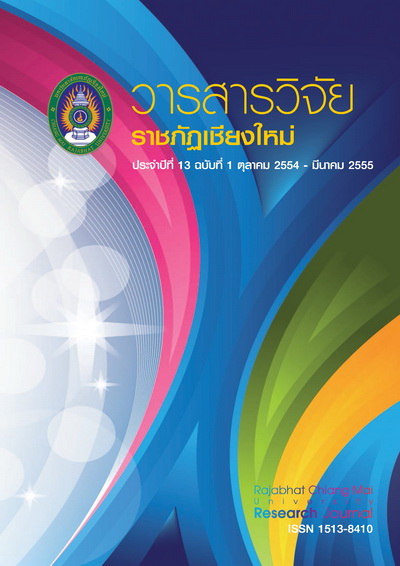การสกัดวิตามินอีจากดิสทิลเลตของน้ำมันรำข้าว
DOI:
https://doi.org/10.14456/rcmrj.2012.96102Keywords:
การสกัด, วิตามินอี, โท โค เพ่อรอล, ดิสทิลเลตของนํ้ามันรำข้าว, BHT, TBHQ และ BHAExtraction, Vitamin E, Tocopherol, Distillate of rice bran oil, TBHQ and BHAAbstract
การสกัดวิตามินอีจากดิสทิลเลตของนํ้ามันรำขาว ด้วยสัดส่วนของดิสทิลเลตต่ออะซิโตไนไตรล์เท่ากับ 1:4 (พ/V)
โดยวิธี winterization ที่อุณหภูมิ0 และ -20°c ตามลำดับ ทำบริสุทธสารสกัดที่ได้ด้วยการทำซาพอนิฟิเคชันแบบเย็น(cold saponification) วิเคราะห์หาปริมาณวิตามินอีด้วยเทคนิค Reversed-phase HPLC พบว่า ความเข้มข้นของวิตามินอี เท่ากับ 6,788.186+55.039 mg/kg สารสกัดวิตามินอีที่สกัดได้จากดิสทิลเลตของนํ้ามันรำข้าวเข้มข้น 0.1mg/kg มีค่า DPPH scavenging effect สูงที่สุดเท่ากับ 98.178±0.004% และมากกว่าแอลฟา-โทโคเพ่อรอลสังเคราะห์,BHT, TBHQ และ BHA ตามลำดับ อย่างมีนัยสำคัญทางสถิติ (p<0.05) และสามารถยับยั้งการเถิดเปอร์ออกซิเดชันของกรดลิโนเลอิกได้มากกว่า 90% ภายในเวลา 24 ชั่วโมง เมื่อทดสอบโดยวิธี reducing power และ วิธี ferric thiocyanate นอกจากนี้ยังมีสมบัติต้านการเถิดออกซิเดชันและความสามารถในการจับอนุมูลอิสระซูเปอร์ออกไซด์มากกว่าแอลฟา-โทโคเพ่อรอลสังเคราะห์ BHT TBHQ และ BHA ตามลำดับ อย่างมีนัยสำคัญทางสถิติ (p<0.05)
Extraction of Vitamin E from Distillate of Rice Bran Oil
The extraction of vitamin E from rice bran oil deodorizer distillate with distillate to acetonitrile ratios of 1:4 w/v by winterization at temperatures of 0 and -20°c respectively, purified extracted vitamin E by cold saponification. Vitamin E concentration in the extract was determined using Reversed-phase HPLC. The concentration of extracted vitamin E was 6,788.186+55.039 mg/kg. The maximum DPPH scavenging effect of 0.1 mg/kg extracted vitamin E was 98.178+0.004% and significantly (p<0.05) greater than synthetic
a-tocopherol, BHT, TBHQ and BHA respectively. According to the methods of reducing power and ferric thiocyanate, the extract with vitamin E concentration of 0.1 mg/kg could inhibit the peroxidation of linoleic more than 90% in 24 hours. The antioxidative properties and superoxide scavenging activity of the extracted vitamin E was significantly (p<0.05) greater than synthetic a-tocopherol, BHT, TBHQ and BHA respectively.
Downloads
Downloads
How to Cite
Issue
Section
License
1. Articles, information, content, images, etc published in the “Community and Social Development Journal” are copyrighted by the Community and Social Development Journal, Chiang Mai Rajabhat University. In order to properly distribute the articles through print and electronic media, the authors still hold the copyright for the published articles under the Creative Commons Attribution (CC BY) license, which allows the re-distribution of the articles in other sources. References must be made to the articles in the journal. The authors are responsible for requesting permission to reproduce copyrighted content from other sources.
2. The content of the articles appearing in the journal is the direct responsibility of the article authors. The editorial board of the journal does not necessarily agree with or share any responsibility.














